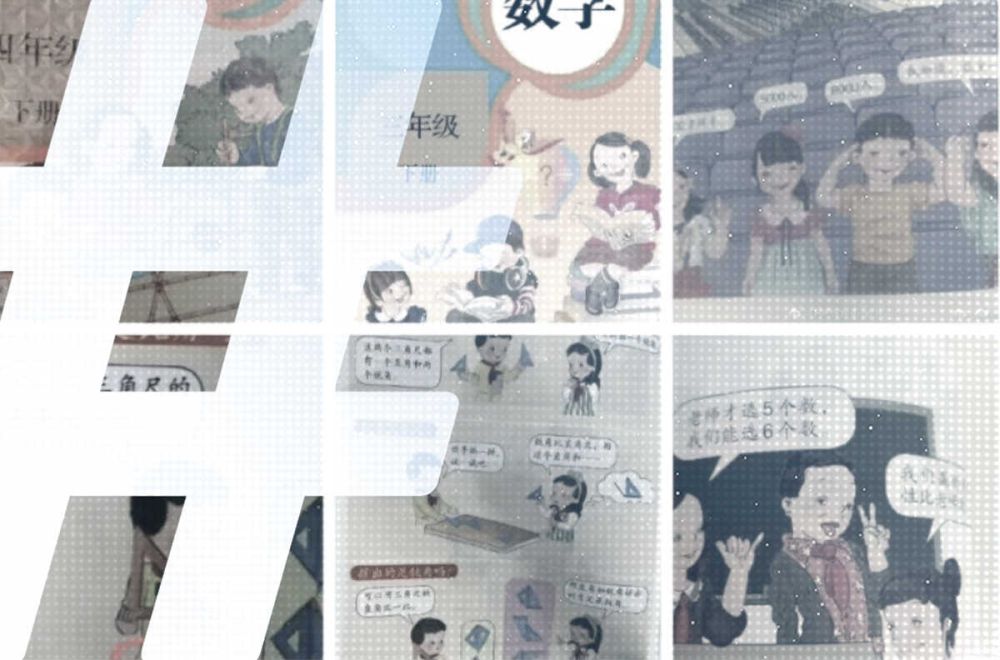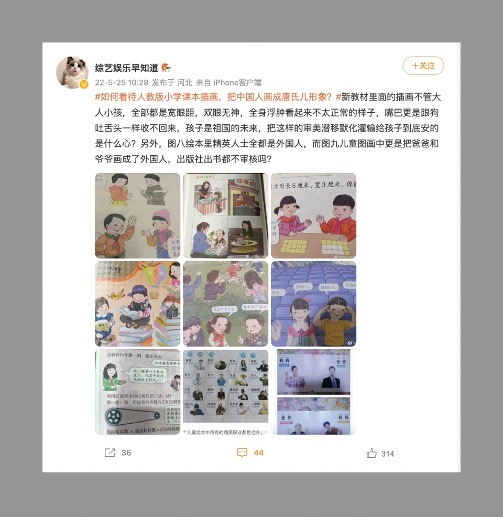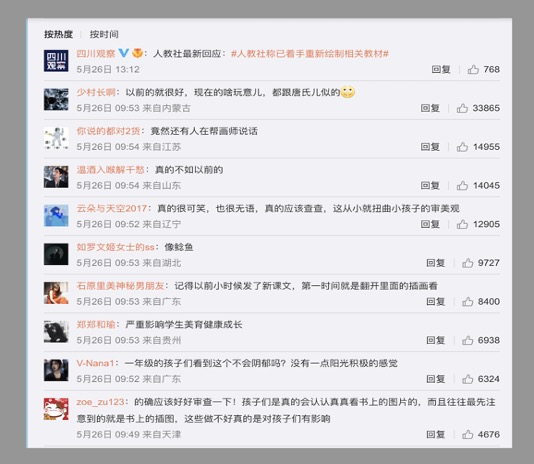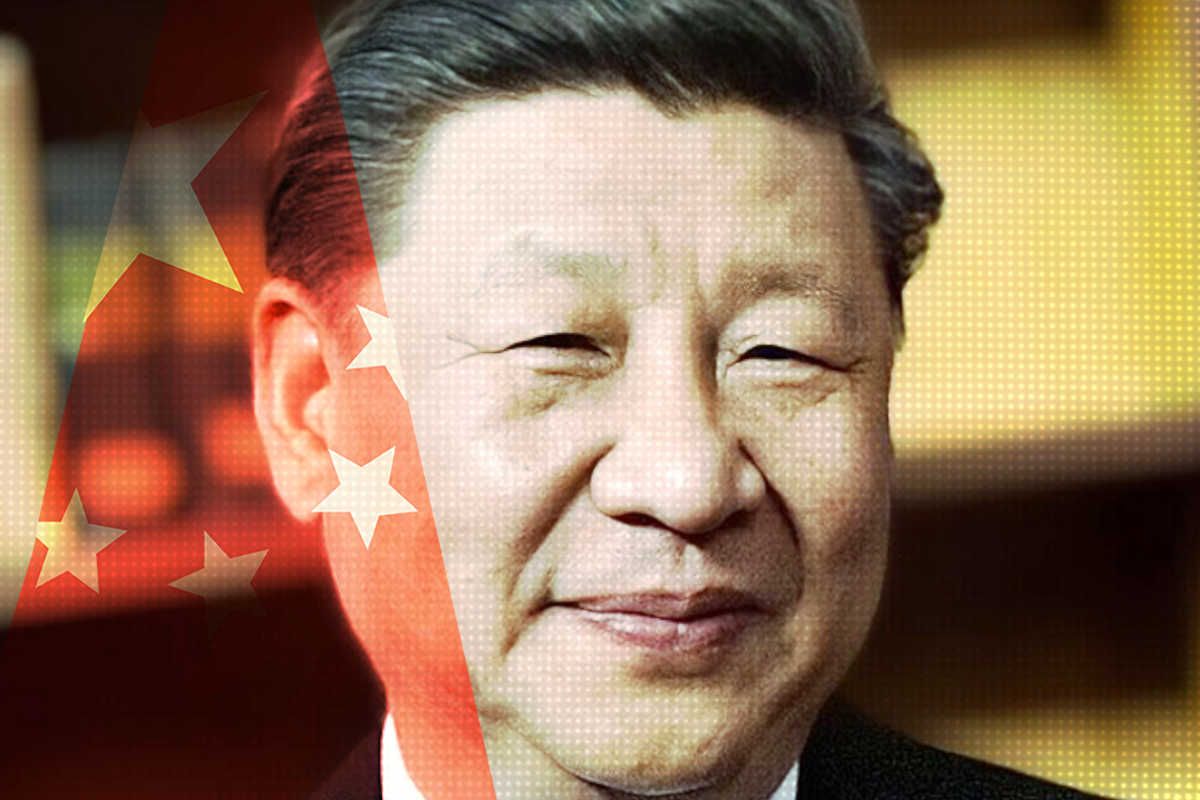Headlines and Hashtags
Shades of Hostility

Last month, a set of questionable illustrations included in primary school mathematics textbooks in China sparked a fierce debate online over quality control and curriculum standards. Most agreed that the illustrations, included in texts published by the People’s Education Press, were in poor taste. One image showed a schoolgirl with her underwear exposed; another a student being grabbed from behind.
But in a sign of how quickly tensions within Chinese society can lead to caustic speculation about foreign influence and infiltration, particularly in the midst of charged relations with the United States and the West, many Chinese saw the tell-tale signs of a foreign conspiracy, despite the fact that internal standards of political discipline within media and publishing in China are among the strictest in the world.
While such nationalistic readings of the affair were not broadly representative of Chinese public opinion, and did not appear directly in mainstream CCP media, they were influential enough to merit a cautionary comment from one of China’s most inveterately anti-Western commentators, former Global Times editor-in-chief Hu Xijin (胡锡进). In a post over the weekend, Hu welcomed an investigation announced by the Ministry of Education, but also indicated just how sensitive political nerves have become in China when he said he hoped that the investigation could “remain factual, and avoid the expansion of rectification [efforts].”
Using the highly loaded historical term “position,” or zhengdi (阵地) – suggesting ideological ground that must be held against the enemy – Hu said the errors were not an indication that “ideological positions have been lost, and educational positions taken over by hostile forces.” Instead, said Hu, the errors in were “likely to have been the result of management-level problems.” He let the cat out of the bag in terms of ultimate responsibility as he said: “It is important to recognize that the position of Chinese education is generally solid, and the entire publishing industry has long been under the leadership of the Party and in the hands of those who love the Party and love the nation.”
How did this odd affair evolve? And why did it prompt such an outpouring of nationalistic fury?
Artistic Standards and Infiltration
The controversy kicked off on May 25, as users on Chinese social media shared images from the mathematics textbooks in question. Discussions centered initially on aesthetic considerations: Were the images acceptable, or were they simply ugly?
One early post to Weibo that day noted the oddness of the illustrations and urged further investigation of the causes. “I took out my math textbooks and had a look, and I really hadn’t noticed before how the people’s eyes were less spirited than those of cats, dogs or monkeys,” they wrote. “This happens not just once or twice, but everywhere . . . In some the gazes are indifferent, in others the eyes rolling, or askant, not really looking at things or taking them in. The whole thing feels weird.”

“With so many children in the country using these texts, what is the reason for this?” the post asked. “This is a big deal, something that can’t just be passed over. There needs to be an investigation and explanation.”
Another post to Weibo at 10:28AM that day reflected generally on textbook illustrations in China, including images of the mathematics textbook illustrations that would soon be national news as well as others they felt were problematic. “The illustrations in new textbooks, whether for adults or for children, all have wide eye spacing, puffy eyes, and a puffy appearance, and mouths that are as puffy as those of dogs,” the post read. “Children are the future of our country, so what is the intention in encouraging such aesthetics in children?”

The post also bemoaned the fact that the images for professions such as doctors, lawyers and professors in children’s textbooks were often those of foreigners. “Do publishers not review these books?” they asked.
As the comments gathered, so did the outrage, and by May 26, the People’s Education Press images were becoming a full-blown national controversy. As many media would eventually note, including Hangzhou’s Metro Express (都市快报), the textbook illustrations controversy accounted for seven of the top 10 search results in China that day.
Just before 10AM on May 26, “Sichuan Observation” (四川观察), the official Weibo account of Sichuan Radio and Television (SCTV), the provincial government broadcaster, posted a video about the brewing controversy over the textbook illustrations, asking its eight million followers to weigh in with their views. Respondents expressed strong disapproval of the images, many saying that they affected the healthy development of children. “Textbook illustrations in the past were much better,” one wrote. “Now these children in the illustrations all look like they have intellectual disabilities. It’s ridiculous and leaves me speechless, and someone really needs to look into this. It distorts the aesthetics of children.”

Just minutes later, the SCTV video post was shared by the official account of the well-known magazine China News Weekly (中国新闻周刊), which has more than 60 million followers on Weibo. As users there commented on the images, speculations about a foreign conspiracy became more prevalent.
Some users pointed out that children in the illustrations were wearing clothes sporting stars-and-stripes patterns reminiscent of the American flag. The focus on this and other such details prompted many to conclude that the images showed an adoration of American culture while looking down on more natively Chinese representations. “This is not a problem of artistic standards but a problem of ideology,” wrote one respondent. “The problem of ideological infiltration of education is really serious. Do you really not get this?”

Just after noon on May 26, the People’s Education Press issued a statement through its official Weibo account saying that it acknowledged the criticisms online, and that it was taking steps to review the illustrations in question and “further improve design quality.” But many internet users continued to reject the suggestion that this was about aesthetic standards at all.
“The problem of ideological infiltration of education is really serious. Do you really not get this?”
comment on Chinese social media
“You make this out as about ‘artistic standards’? That really is making light of the serious!” read one furious comment on Weibo. “You bring shame to the word ‘people’ appearing in your name,” said another immediately after, vaguely invoking an ideological struggle behind the scenes.
Anger was also heaped on the illustrator responsible for the images.
Internet users had revealed quite quickly on May 25 that the images had been made by Beijing Wu Yong Design Studio (北京吴勇设计工作室), a group run by the graphic artist Wu Yong (吴勇), a graduate of the Central Academy of Arts and Crafts (later Tsinghua University’s Academy of Arts and Design). Wu had a varied design background that included book illustration. Many had pointed to a 2018 interview Wu had done with ZCOOL (站酷), a website for the designer community, that had included the mathematics illustrations among other work.

These biographical details, including many of Wu’s comments on design, were reported widely on May 26 by a range of media, including The Paper, which pulled out a kicker quote from Wu that came across as highly ironic given the outrage cresting online over the designer’s depiction of schoolchildren: “And so, it is among students that we most see the heart of the child. They have ideals in their hearts, pure passion and flickering sparks of wisdom. This is such a precious thing!”
These words from four years earlier contrasted starkly with the denunciations that continued online. “The ugliness of these pictures really conveys the chaotic intention behind, showing how vile the designer really is!” one user wrote in the comment space under a post by the Weibo account of Computer Weekly. “Is this Wu Yong not a traitorous dog?” asked another just below.
Hostile Conspiracies
On top of the growing list of supposedly foreign-inspired elements in the illustrations themselves, the details of Wu Yong’s background fueled conspiracies about foreign infiltration. In the ZCOOL interview, Wu had been identified as a member of the Alliance Graphique Internationale (AGI), a global club of graphic designers, and also as “artistic adviser” for the Beijing office of the United Nations Children’s Fund (UNICEF). These completely circumstantial details were taken as evidence of foreign collusion. Meanwhile, further reporting into Wu’s studio, such as a May 27 article from the Beijing Youth Daily revealing that it was not in fact registered as a commercial enterprise, further invited suspicion among the already suspicious.
On May 27, “Gathering Light Chronicle” (拾光纪事), a WeChat public account that frequently features anti-Western and anti-American content as well at attacks on more liberal media inside China, ran a provocative post called “The Infiltration of Textbook Illustrations by Hostile Forces, A Secret Conspiracy of Cultural Colonization,” which highlighted Wu Yong’s UNICEF connection. “The Wu Yong Design Studio that did the layout and illustration is backed as an artistic adviser by UNICEF, a foundation dedicated to promoting the LGBT movement among our country’s youth population,” the post read.
The post also compared Wu Yong’s illustrations in the mathematics text with more “normal” illustrations in a language text – the standard for normal apparently being those with more traditionally Chinese motifs.

“I believe normal people would choose the drawing style on the left, because it is what we would call normal,” the post said. “No one likes the drawing style on the right because it is a weak-minded drawing style that deliberately scandalizes our Chinese children and deliberately promotes slave education to try to change our aesthetic standards by subtle means.”
Here, even before the question of ultimate foreign responsibility was posed, the reason for the existence of these hated textbook illustrations was implied. The term “slave education” (奴化教育) – used by the Chinese Communist Party throughout its past to criticize Japanese, American, British and other forms of colonialism – suggested that this was part of a process of systematic transformation and indoctrination by outsiders. “So, why is there such a big difference between the same version of the textbook?” the post continued. “There’s an answer to that, and it’s clearly intentional. This cannot be explained or washed away.”
The post then alleged that the textbook illustrations were “a trick of cultural colonization,” a clear-cut case of intrusion by “hostile forces” that had “infiltrated our education system and are recklessly changing our illustrations in an attempt to change our aesthetic standards.” For “Gathering Light Chronicle,” the core question was plain as day: “[How] did the hostile forces infiltrate our education system? How did such ghostly illustrations get so overtly into our textbooks?”
The post from “Gathering Light Chronicle” was shared by other sites, including the leftist website Utopia (乌有之乡). And there were similar posts from other accounts, including this May 27 post that waxed nostalgic about the textbooks of China’s past, adding a clear note of conspiracy. “Thinking back on these details, it’s like returning to our childhood, when illustrators had a positive outlook, did not receive funding from overseas NGOs, and apparently only tried to make the characters as simple and beautiful as possible.”
Mitigating Contexts
But much of the nationalist sentiment flaring up against the People’s Education Press illustrations concealed a very basic question. How could such apparently flagrant lapses in textbook illustration quality happen at a state-owned publisher? And how had this issue escaped notice for more than a decade, these very textbooks lingering in the homes of millions of Chinese families?
In a May 27 commentary on the incident through its social media accounts, the CCP’s official People’s Daily newspaper said that the design and writing of learning materials required “a fierce sense of responsibility and mission, strictly upholding a correct political direction and value orientation.” As many official news outlets noted, including Jimu News, a new media channel run by the provincial Hubei Daily, book publications in China must go through a strict review process that includes three rounds of close examination and three further proof-readings. These are meant to address major problems not just in terms of content and structure, but also in political and ideological direction.
How could such political standards not be upheld in the first place – under a system that has always prioritized such controls?
One problem, according to an editor interviewed by Jimu News, is that the focus on political and ideological issues at the level of the text means that images and illustrations are often neglected. “Pictures are generally drawn by illustrators, and this does not fall within the purview of reviews and controls,” the editor said.
In fact, illustrations may even be added to a book outside the review process altogether, meaning that they completely avoid this cycle of three reviews and three proofreads. “That’s why it’s easy to make mistakes,” said the editor. “I believe this incident will become the focus of training for publishers for related censorship and reviews from here on out.”
Some Chinese commenting on social media, including a number of artists and graphic designers, advanced other arguments that provided some context for why poor-quality design might happen, including details about the publishing industry and the design profession. In a post on May 25, a Beijing-based computer graphic artist with more than three million followers on Weibo responded to the then developing controversy over textbook illustrations by suggesting that one key problem was that publishers had not kept pace in their budgeting over the past 20 years, as the cost of quality design work had grown.
This post angered many internet users, who felt that this was “mopping the floor” (洗地) – or making convenient excuses for the guilty.
“I believe this incident will become the focus of training for publishers for related censorship and reviews from here on out.”
Textbook Editor
On May 27, Shanghai’s Guancha Syndicate published a post in which Fu Luola (傅洛拉), an author with experience in education, gave a rather even-handed assessment of various factors that might have led to the publication of the illustrations in question, and to the controversy that exploded this year. While acknowledging some of the budget considerations noted in the earlier post by the Beijing-based computer graphic artist, Fu Luola agreed that illustrations in this case were substandard. “It was certainly unacceptable for Wu Yong’s studio to release works like this,” they wrote.
Fu suggested, however, that the decisions behind the case were probably far more basic that the conspiracies entertained by many internet users, including understandable personal and professional relationships between people at the publishing house and Beijing Wu Yong Design Studio: “But on the publisher’s side, it is likely that the first step in committing this mistake was simply that a member of the math textbook writing team happened to have connections to the studio and blindly believed in its name and its ‘artistic sensibility.’”
The author affirmed the “importance of public oversight” in the industry to avoid “problematic public opinion events.” But also at play, they said, was the larger social and political context that textbook publishers and reviewers could not have anticipated more than 10 years ago.
Specifically, the author suggested that changes in societal views about “insults to China” and the deterioration of China-US relations had contributed to the animus against the illustrations. “A second [issue] is that the standpoints of evaluation are also changing as concepts in society change. Between 2012 and 2013, when this set of textbooks was being reviewed, there had been no concentrated cases of ‘squinting’ and other ‘insults to China’ of the kind that have caused a lot of controversy in recent years.”
Buried amid the heaps of social media discussion about illustration quality, ugliness and treachery, this simple point was perhaps one of the most perceptive. A general surge in animosity towards the United States and the West in China — stemming from growing international tensions but fueled also by calls in the leadership and state-run media against criticism, containment and perceived threats to “cultural security” — was almost certainly one of the key changes in context adding shades of hostility to the recent textbook illustration controversy.
But all reason aside, this measured reading of the case was rejected by many commenting below the Guancha Syndicate post, who chose to understand the incident as a serious assault on the country.
“They have violated the publishing laws and criminal laws!” one user wrote erroneously. “It’s not a matter of self-correction anymore! These people are simply a fifth column planted in China by the West!”






















